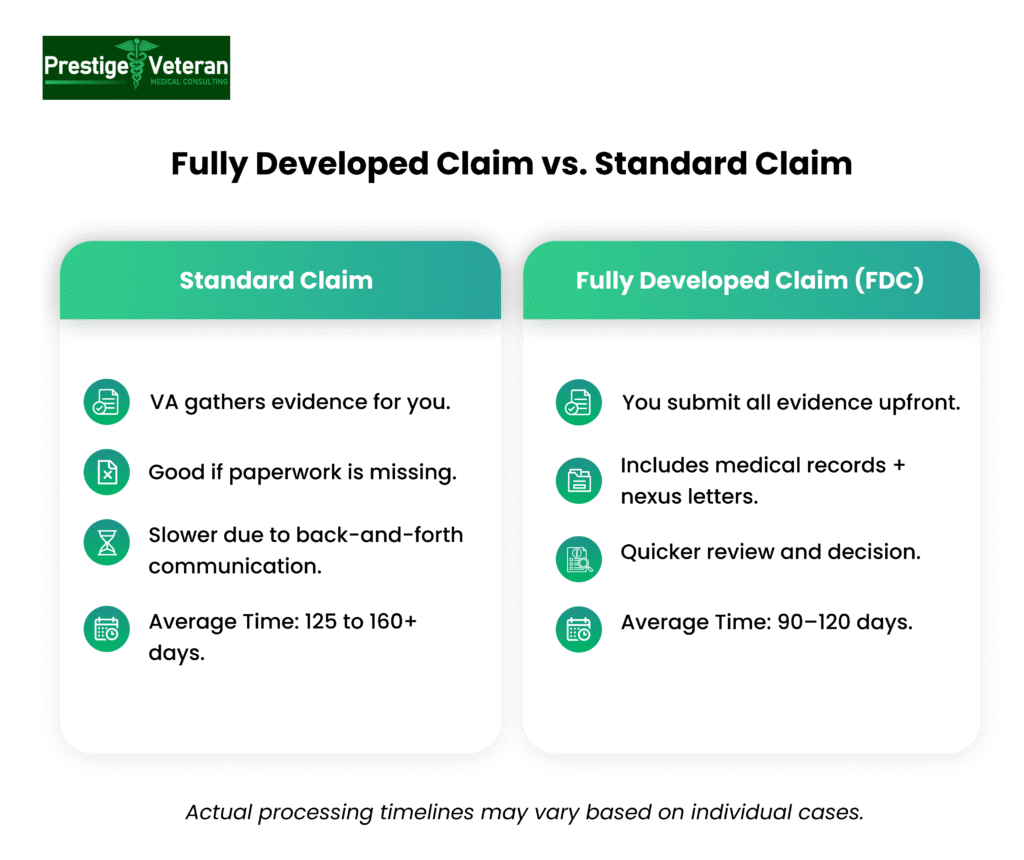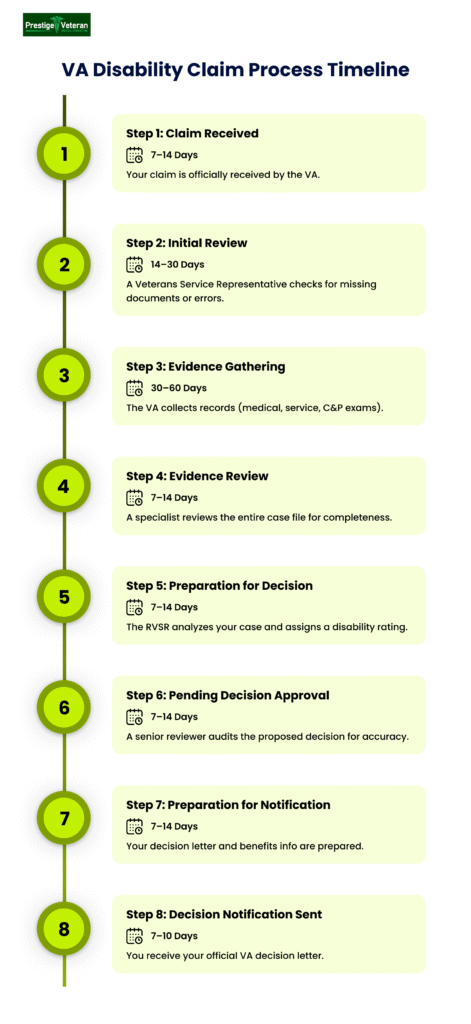Last Updated on 22 July, 2025
Veterans seeking disability compensation often ask, “How long does a VA claim take?” The answer depends on several factors, including the type of claim filed, the complexity of the service-connected conditions, and how quickly the VA gathers necessary evidence. The Department of Veterans Affairs reveals that the current average processing time is approximately 100.4 days.
Whether you are just beginning your VA compensation journey or are stuck at a specific stage, this guide breaks down each step of a VA claim timeline. Moreover, discover the average days VA takes to process a VA claim based on location and expert tips on how to expedite your claims.
Table of Contents
What Is a Fully Developed Claim vs. a Standard Claim?
When starting the VA disability process, one of the most important decisions you will make is choosing between a Standard Claim and a Fully Developed Claim (FDC). What you decide between the two can significantly affect how long your VA claim takes.

Standard Claim
A Standard Claim lets the VA gather supporting evidence for you, for example, medical records, service treatment records, and other documentation.
- Useful if you are missing paperwork or unsure what to include
- Often results in a longer processing time because the VA needs time to gather evidence and communicate back and forth with you
Fully Developed Claim (FDC)
On the other hand, a Fully Developed Claim, filed using VA Form 21-526EZ, can speed things up.
- With an FDC, you are responsible for submitting all necessary evidence upfront, including medical records (private and VA), service treatment records, and nexus letters
- You also certify that no additional disability-related evidence will be submitted
- Minimizes delays by allowing the VA to begin reviewing your claim immediately
If you have all your documentation in order and are looking to file a VA disability claim faster, choosing the Fully Developed Claim (FDC) can reduce your wait time by weeks or even months. If you are confused about which type of claim is right for you, a VA-accredited representative can help guide you.
What are the 8 Steps to a VA Claim?

Understanding the stages of a VA claim allows veterans to better prepare and manage expectations through the process. The VA follows a structured 8-step timeline to process claims, each phase playing a critical role in determining your eligibility, compensation, and benefits.
Step 1: Claim Received (7–14 Days)
Once you submit a VA disability claim, either online or via mail, it enters the “Claim Received” status. This is your confirmation that the VA has officially received your application. If you applied online, you will see an on-screen confirmation immediately. For paper submissions, the VA will mail a letter typically within 1–2 weeks.
This crucial Step 1 not only marks the beginning of your VA claim status timeline but also helps lock in your effective date, the date from which you could begin receiving back pay if your case is approved.
Step 2: Initial Review (14–30 Days)
In the initial review phase, a Veterans Service Representative (VSR) checks your file for obvious errors or missing documentation. This includes verifying your identity details like your name, date of birth, and Social Security number, as well as confirming receipt of required forms and documents.
If something’s missing, the VA will contact you for clarification, which can delay your progress. Step 2 is when the VA decides whether your application is a Fully Developed Claim or a standard claim that requires further development to move forward into evidence gathering. Hence, filing an accurate disability application keeps your VA claim stages on track.
Step 3: Evidence Gathering (30–60 Days)
The evidence gathering phase is often the longest and most critical phase of the VA claim process, typically lasting between 1 to 2 months. During the step 3, the VA gathers supporting evidence from veterans, which may include:
- Service treatment records
- VA medical records
- Private medical records
- Medical nexus letters or buddy letters
- Compensation & Pension (C&P) exam results
You may be asked to complete additional forms or authorize record requests. If the VA cannot obtain the records directly, you may need to submit them yourself. Many veterans are also scheduled for a C&P examination to assess the severity and service connection of their condition. If you miss this exam, your case could be denied outright.
Your VA disability claim can return to this phase multiple times if new evidence is submitted.
Step 4: Evidence Review (7–14 Days)
Once all necessary documents are collected, a Rating Veterans Service Representative (RVSR) begins reviewing the evidence file during Step 4. They examine every item for relevance, credibility, and completeness. If they find the evidence insufficient or if you submit additional documentation at this point, your disability benefits case may return to Step 3.
Step 4 of a VA claim typically takes 1 to 2 weeks, but the timeline can vary based on workload or complexity. At this point, no action is required from veterans unless requested. Patience is essential, and checking your status regularly helps you stay informed.
Step 5: Preparation for Decision (7–14 Days)
At this stage, the RVSR finalizes their recommendation for your benefits. They assess all evidence and determine whether your disability is service-connected. The RVSR may examine your C&P results, buddy statements, nexus letters, and service records to form a well-supported decision. Using the VA’s Schedule for Rating Disabilities, they will assign a disability rating based on severity and impact on your ability to work.
Step 5 of the VA claims process usually lasts between 1 to 2 weeks, but it may take longer for complicated cases. The decision phase is crucial as your assigned rating directly impacts your monthly compensation and eligibility for additional benefits.
Step 6: Pending Decision Approval (7–14 Days)
During Step 6 of the VA claim timeline, the proposed decision undergoes a final review by a senior adjudicator. This is the VA’s internal quality assurance step to ensure legal, procedural, and regulatory compliance.
Usually, Step 6 of a VA claim takes between 7 to 14 days; however, it may extend longer for multi-condition or complex cases. For example, disability claims involving PTSD, TDIU (unemployability), or secondary conditions are more likely to undergo closer scrutiny.
This VA claim stage doesn’t require input from the veteran unless an issue arises. It’s a sign your case is nearing completion but is not yet finalized.
Step 7: Preparation for Notification (7–14 Days)
Once approved, the VA prepares your decision letter and benefit details. Step 7 of the VA claim timeline involves gathering evidence, for example:
- Your VA disability rating
- Monthly benefit amount
- Effective date of payments
- Explanation of findings
You can expect this phase to be completed within 1 to 2 weeks, depending on processing workloads. The step signifies that a final decision has been made. If any issues arise during quality checks, your application may return to a prior stage. The VA also updates the online claim tracker during this phase.
Step 8: Decision Notification Sent (7–10 Days)
Step 8 represents the final stage of the VA claim process. During this phase, the VA sends your decision letter by mail, typically within 7 to 10 business days. However, delays can sometimes occur.
The decision packet includes:
- The official rating decision
- Instructions for filing an appeal if the VA has denied your case
- A detailed explanation of the outcome
You can check your VA claim status online at the VA.gov account or call 1-800-827-1000 and talk to a VA representative.
You can download your decision letter in the claim status tool. If you do not receive your letter within the expected timeframe, it’s recommended to either log into your VA account or contact the VA directly for updates.
Average Days to Complete VA Claims by Location
Understanding how long it takes to process a VA disability claim depends heavily on where the claim is handled.
This table presents a state-level overview of the average number of days required to complete VA claims processing in 2025:
- ADC Month-to-Date (MTD): Represents the average number of days taken to complete a VA disability claim during the current month.
- ADC Fiscal Year-to-Date (FYTD): Represents the average number of days taken to complete a VA claim from the beginning of the current fiscal year to date.
| State | ADC MTD | ADC FYTD |
| USA – All Missions Total | 100.9 | 128.7 |
| Northeast District | 106.3 | 132.2 |
| Connecticut | 110.0 | 132.6 |
| Delaware | 106.4 | 129.5 |
| District of Columbia | 100.2 | 134.6 |
| Illinois | 108.2 | 134.2 |
| Indiana | 103.2 | 128.9 |
| Maine | 101.4 | 139.2 |
| Maryland | 96.0 | 127.7 |
| Massachusetts | 114.4 | 136.8 |
| Michigan | 107.3 | 132.3 |
| Missouri | 101.1 | 129.3 |
| New Hampshire | 108.5 | 133.7 |
| New Jersey | 111.6 | 139.4 |
| New York | 108.1 | 131.4 |
| Ohio | 106.8 | 131.4 |
| Pennsylvania | 109.0 | 134.6 |
| Rhode Island | 112.2 | 131.9 |
| Vermont | 141.3 | 145.5 |
| Wisconsin | 103.4 | 128.2 |
Note: VA claim processing times change regularly and vary by location. For the most recent numbers, see the Veterans Benefits Administration Reports Detailed Claims Data. The averages shown above are examples only and will not reflect real-time figures.
How to Speed Up Your VA Disability Claim?
Many veterans understandably ask how to expedite a VA claim, especially when they are dealing with serious health issues or financial stress. While the VA’s timeline isn’t fully within your control, there are legitimate ways to request faster VA disability approval.
1. Request Priority Processing
You may qualify for priority processing if you meet specific criteria, such as:
- Experiencing extreme financial hardship, homelessness, or having a terminal illness
- Age 85 or older
- A recipient of the Purple Heart or Medal of Honor
- A former Prisoner of War (POW)
To apply, use the VA’s Priority Processing Request form (VA Form 20-10207) or include a supporting statement with your claim.
2. File a Fully Developed Claim (FDC)
Another proven strategy is to file a Fully Developed Claim (FDC), which means submitting all required documents, like medical records, completed VA forms, and nexus letters, at the start. For example, missing a key form or service treatment record can send your claim back to the evidence-gathering phase, slowing everything down.
3. Check Eligibility for VA Presumptive Conditions
If your illness is on the VA’s list of presumptive conditions, you may qualify for a faster decision. These conditions, linked to exposures like Agent Orange or burn pits, don’t often require a nexus letter; just a diagnosis and proof of service is enough. This streamlined process helps speed up approval and reduces the risk of denial.
4. Use the Benefits Delivery at Discharge (BDD) Program
If you are still on active duty and within 90–180 days of separation, consider the Benefits Delivery at Discharge (BDD) program, which begins the claim process before you leave service.
Remember, not every veteran’s disability case qualifies for priority processing. In fact, submitting a complete, well-prepared claim and responding promptly to the VA requests is the surest way to a faster VA disability approval.
Factors That Influence the VA Claim Timeline
Though the average time to process a VA disability claim is 4 to 6 months, the actual processing timeline varies greatly. The biggest influencing factors include:
1. Type of Claim
One major factor affecting the VA claims timeline is the type of claim filed. Claims filed under the Fully Developed Claim (FDC) program usually move faster, while Standard Claims take longer to process as the VA collects records on your behalf.
2. Number and Complexity of Conditions
A disability compensation claim with one or two conditions, such as tinnitus or a minor orthopedic issue, is simpler to evaluate. However, claims involving multiple or complex conditions like PTSD, traumatic brain injury, or secondary conditions may require more documentation and medical review.
3. Compensation and Pension Exams
If the VA schedules a Compensation and Pension (C&P) exam, any delay in attendance or rescheduling can impact the claim timeline. These evaluations help the VA assess the severity and service connection of your condition, influencing your final VA rating. Hence, make sure to attend your scheduled C&P exam without fail.
4. Evidence Gaps
Missing medical documentation or service treatment records often forces the VA to issue formal requests, which may take weeks. Submitting incomplete evidence or adding new documents later in the process can also send your claim back to earlier stages for re-evaluation.
5. Regional Office Workload
Where your claim is processed can greatly impact your VA disability timeline. VA Regional Offices with high-volume claims or staff shortages may face backlogs, especially during peak periods, which can lead to slower processing times.
According to the latest VBA reports, there are nearly 173,166 backlogged disability and pension claims pending for more than 125 days.
6. Appeals and Supplemental Claims
If you want to appeal an unfavorable VA claim decision, expect longer processing times. Under the Appeals Modernization Act (AMA), each option has its own timeline:
- Supplemental Claim (VA Form 20-0995)
This option requires submitting new, relevant evidence, which typically takes around 125–140 days to process. - Higher-Level Review (VA Form 20-0996)
Request a fresh review of your existing VA claim. No new evidence is needed. A higher-level review can be completed in 120–150 days. - Board of Veterans’ Appeals (VA Form 10182)
Ideal for complex or disputed claims, a Board Appeal involves a review by a Veterans Law Judge and may take 1 to 2 years for a decision.
Understanding what affects the current VA claim processing time helps set expectations. Moreover, working with VA-accredited attorneys or professionals can improve outcomes and reduce delays.
What Speeds Up / Slows Down a VA Claim?
Based on the VA claims process overview, certain actions and circumstances can either shorten or lengthen your VA disability claim timeline. By understanding these factors, veterans can take proactive steps to avoid unnecessary delays and keep their claim moving forward.
|
Speeds Up |
Slows Down |
|
Fully Developed Claim (FDC) with all evidence included upfront |
Missing a scheduled Compensation & Pension (C&P) exam |
|
Attending all scheduled C&P exams without rescheduling |
Submitting incomplete or inconsistent evidence |
|
Responding quickly to VA requests |
Adding new evidence mid-review |
|
Using Benefits Delivery at Discharge (BDD) if within 90-180 days of leaving service |
Filing complex, multi-condition claims |
|
Priority processing (terminal illness, age 85+, POW, Medal of Honor, Purple Heart, extreme hardship) |
Processing at a regional office with a high backlog |
|
Presumptive conditions – no nexus letter required |
Appeals or deferred claims |
What If Your VA Claim Is Deferred?
If you receive a deferred VA claim status, this means the VA needs more information before making a decision. While it’s not a denial, deferred claims can extend your wait by weeks or months.
Top reasons why VA claims get deferred include:
- Missing or incomplete medical records
- Service records that require verification
- A lack of details on the service-connected disability in the C&P exam
- Additional information needed from a private or VA doctor
For example: If you file a claim for migraine headache but your C&P exam doesn’t clearly link the condition to your military service (known as a “nexus”), the VA may defer your claim until a proper medical opinion is submitted.
To avoid further delays in the VA claims process, respond promptly to VA letters and submit requested evidence. Consider working with a Veteran Service Officer (VSO) or VA-accredited attorney for guidance.
Case Study 1: TDIU (Individual Unemployability) Claim
Veteran: James R., U.S. Army, Gulf War-era
Claim Type: TDIU (Total Disability based on Individual Unemployability)
Conditions: Chronic back pain (secondary to airborne injury), Major Depressive Disorder
Background:
James filed for TDIU in January 2025 after years of being unable to work due to disabling back pain and depression. With help from a VSO, he submitted a Fully Developed Claim that included a vocational assessment and consistent treatment records.
Claim Timeline
- January 2, 2025 – Submitted a Fully Developed Claim
- February 22, 2025 – C&P exam completed
- March 10, 2025 – Evidence gathering completed
- May 30, 2025 – Decision prepared by VA rater (entered Step 6: Pending Approval)
- June 20, 2025 – Final decision sent (via VA.gov and mailed letter received June 26)
Outcome: Granted 100% rating
Duration: 169 days
Retroactive Pay: ~$10,500
Notes:
Strong evidence and a thorough C&P exam helped James avoid appeal. He said, “This decision gave me peace. I can finally live without the pressure of pretending I’m okay.”
Case Study 2: PTSD VA Claim
Veteran: Maria L., U.S. Marine Corps, Afghanistan (OEF/OIF)
Claim Type: PTSD with secondary insomnia
Conditions: PTSD, chronic insomnia, anxiety
Background:
Maria developed PTSD after traumatic combat exposure and delayed filing due to stigma. In August 2024, she submitted a Standard Claim with therapy notes and buddy statements. She missed her first C&P exam due to anxiety but rescheduled successfully.
Claim Timeline
- August 10, 2024 – Submitted a Standard Claim
- September 25, 2024 – Original C&P exam scheduled
- October 24, 2024 – Rescheduled C&P exam completed
- December 3, 2024 – Evidence review completed (VA obtained therapist letters and lay statements)
- January 15, 2025 – Rating decision finalized
- February 2, 2025 – Decision notification mailed and uploaded to VA.gov
Duration: 177 days
Outcome: Secured a 70% PTSD rating
Retroactive Pay: ~$10,500
Notes:
Maria now receives weekly VA counseling and plans to apply for TDIU. She shared, “I didn’t expect the VA to understand, but they did. That changed everything.”
How to Prove Your VA Disability Claim
Proving your VA disability claim involves meeting three core criteria: a current diagnosis, an in-service event, and a link or nexus between the two. Successfully establishing these elements is essential to receiving compensation.
VA.GOV has details on submitting your disability compensation case using VA Form 21-526EZ.
1. Current Diagnosis:
The VA won’t grant benefits without proof of a current medical condition. This must be documented by a licensed medical professional through VA or private healthcare records. Conditions without a formal diagnosis, even if symptomatic, will be difficult to establish a connection for.
2. In-Service Event, Injury, or Illness:
You must demonstrate that your current disability was caused or aggravated by your time in military service. This can include combat injuries, exposure to hazardous materials, or stress-related incidents.
Supporting documentation might come from service treatment records, deployment logs, or statements from fellow service members (known as “buddy letters”).
3. Nexus Statement:
The “nexus” is a medical opinion that links your current condition to the in-service event. A strong nexus letter from a doctor can significantly boost your chances in some cases. It should state that it is “at least as likely as not” that your disability is service-connected.
Remember that obtaining a nexus statement is not required in advance; the VA C&P exam will likely include a medical opinion. While it may be hard to gauge if it will be a favorable one, it will be provided.
Supporting Evidence to Include:
- DD-214 (discharge papers)
- Military medical and service treatment records
- Private or VA medical records
- Lay statements from family or friends using VA Form 21-10210
- Results from Compensation & Pension (C&P) exams
While attending your C&P exam, honestly explain how your condition affects daily living and your ability to work, without downplaying your symptoms, as its results can greatly influence your VA rating.
The more detailed and consistent your documentation, the stronger your case may become. If your initial claim is denied, consult with a legal professional to discuss your appeal options.
Why You Should Seek Professional Help
Partnering with a Veteran Service Organization (VSO) or an accredited VA disability attorney can significantly increase your chances of VA claim approval.
These professionals help:
- Ensure all forms are correctly filed
- Help gather persuasive evidence
- Assist in drafting nexus letters and lay statements
- Understand how to interpret VA law and policies
- Track and explain VA claim status updates
- Guide you through appeals or delays
If you are stuck at a particular stage, especially Step 5, Step 6, or Step 7 of the VA claim timeline, they can provide you with valuable guidance.
Conclusion
Understanding the VA disability claim timeline and knowing what to expect at each stage can help reduce uncertainty for both veterans and their families. While timelines vary, being organized, responsive, and informed makes a real difference. Don’t hesitate to get support from a VSO or VA-accredited representative, especially if your case becomes complex or delayed.
Many veterans gain a successful outcome and fair compensation when they advocate for themselves persistently throughout the VA claims process. For more information, consult trusted resources or check your claim status on the official website.
FAQs
What is the average wait time for VA disability claims?
The VA takes an average of 107.4 days to complete disability-related claims, though this can vary based on complexity and claim type.
What is the fastest VA claim decision?
The fastest VA claim decision is through the Decision Ready Claim (DRC) program, which can provide a decision in 30 days or less when filed with an accredited Veterans Service Organization (VSO).
How fast can a VA disability be approved?
A VA disability claim can be approved in 30 days or less if submitted through the Decision Ready Claim (DRC) program and all required evidence, such as medical records and a Disability Benefits Questionnaire (DBQ), is included upfront.
What is the hardest VA claim to get?
These VA disability claims are among the hardest to get approved due to higher evidentiary standards.
- Mental health conditions like PTSD, anxiety, or depression without sufficient documentation
- Sleep apnea, tinnitus, or military sexual trauma (MST) without a service connection
- Chronic pain without a confirmed diagnosis
- TDIU (unemployability)
- Complex secondary conditions
How long does Step 7 of a VA claim take to complete?
Step 7 (Preparation for Notification) usually takes 7 to 14 days.
What is the average timeline for Step 6 in a VA claim?
Step 6 (Pending Decision Approval) typically lasts 7 to 14 days, but can be longer for complex claims.
How long will Step 5 of my VA claim take?
Step 5 (Preparation for Decision) usually takes 7 to 14 days, depending on claim complexity.
How long does Step 6 in the VA claim process usually take?
Step 4 (Evidence Review) generally takes 7 to 14 days but may be longer if additional evidence is needed.
What are the steps to check the status of my VA claim online?
You can check your VA claim status online by following these steps:
- Log in to your VA.gov account
- Go to your VA dashboard (located in the top right corner)
- Check Your Claim or Appeal Status to see your claim’s progress.
How often does the VA update claim status?
The VA typically updates claim status at each step in the process, especially when a claim moves to a new phase or new documents are reviewed.
How long does it take for the VA to start paying once a decision is made?
You will typically receive your first VA disability compensation within 15 days after the decision date.
How long are VA claims taking now?
As of July 2025, the VA takes an average of 107.4 days to make a decision on veterans’ disability claims. However, timelines vary based on claim complexity, number of conditions, and regional VA office workloads.
Also read: Understanding the Nexus Letter Success Rate for a VA Disability Claim
At Prestige Veteran Medical Consulting, a veteran-owned company, we specialize in Independent Medical Opinions (IMOs) known as Nexus letters.
Our purpose is to empower YOU, the veteran, to take charge of your medical evidence and provide you with valuable educational tools and research to guide you on your journey.
Understanding the unique challenges veterans face, our commitment lies in delivering exceptional service and support.
Leveraging an extensive network of licensed independent medical professionals, all well-versed in the medical professional aspects of the VA claims process, we review the necessary medical evidence to incorporate in our reports related to your VA Disability Claim.
Prestige Veteran Medical Consulting is not a law firm, accredited claims agent, or affiliated with the Veterans Administration or Veterans Services Organizations. However, we are happy to discuss your case with your accredited VA legal professional.














